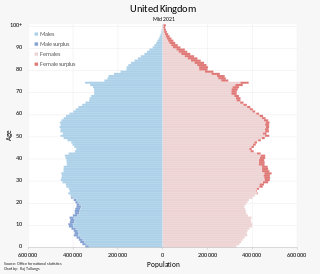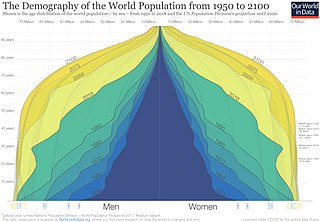Related Research Articles

Statistics is the discipline that concerns the collection, organization, analysis, interpretation, and presentation of data. In applying statistics to a scientific, industrial, or social problem, it is conventional to begin with a statistical population or a statistical model to be studied. Populations can be diverse groups of people or objects such as "all people living in a country" or "every atom composing a crystal". Statistics deals with every aspect of data, including the planning of data collection in terms of the design of surveys and experiments.
The theory of statistics provides a basis for the whole range of techniques, in both study design and data analysis, that are used within applications of statistics. The theory covers approaches to statistical-decision problems and to statistical inference, and the actions and deductions that satisfy the basic principles stated for these different approaches. Within a given approach, statistical theory gives ways of comparing statistical procedures; it can find a best possible procedure within a given context for given statistical problems, or can provide guidance on the choice between alternative procedures.

The population of the United Kingdom was estimated at over 67.0 million in 2020. It is the 21st most populated country in the world and has a population density of 270 people per square kilometre, with England having significantly greater density than Wales, Scotland, and Northern Ireland. Almost a third of the population lives in South East England, which is predominantly urban and suburban, with about 9 million in the capital city, London, whose population density is just over 5,200 per square kilometre.

In the history of the United Kingdom and the British Empire, the Victorian era was the period of Queen Victoria's reign, from 20 June 1837 until her death on 22 January 1901. The era followed the Georgian period and preceded the Edwardian period, and its later half overlaps with the first part of the Belle Époque era of Continental Europe.

Demography is the statistical study of populations, especially human beings.

Lambert Adolphe Jacques Quetelet FRSF or FRSE was a Belgian astronomer, mathematician, statistician and sociologist who founded and directed the Brussels Observatory and was influential in introducing statistical methods to the social sciences. His name is sometimes spelled with an accent as Quételet.

William Farr CB was a British epidemiologist, regarded as one of the founders of medical statistics.

Colonel William Henry Sykes, FRS was an English naturalist who served with the British military in India and was specifically known for his work with the Indian Army as a politician, Indologist and ornithologist. One of the pioneers of the Victorian statistical movement, a founder of the Royal Statistical Society, he conducted surveys and examined the efficiency of army operation. Returning from service in India, he became a director of the East India Company and a member of parliament representing Aberdeen.
Gregory King was an English genealogist, engraver and statistician.

Bills of mortality were the weekly mortality statistics in London, designed to monitor burials from 1592 to 1595 and then continuously from 1603. The responsibility to produce the statistics was chartered in 1611 to the Worshipful Company of Parish Clerks. The bills covered an area that started to expand as London grew from the City of London, before reaching its maximum extent in 1636. New parishes were then only added where ancient parishes within the area were divided. Factors such as the use of suburban cemeteries outside the area, the exemption of extra-parochial places within the area, the wider growth of the metropolis, and that they recorded burials rather than deaths, rendered their data incomplete. Production of the bills went into decline from 1819 as parishes ceased to provide returns, with the last surviving weekly bill dating from 1858. They were superseded by the weekly returns of the Registrar General from 1840, taking in further parishes until 1847. This area became the district of the Metropolitan Board of Works in 1855, the County of London in 1889 and Inner London in 1965.

André-Michel Guerry was a French lawyer and amateur statistician. Together with Adolphe Quetelet he may be regarded as the founder of moral statistics which led to the development of criminology, sociology and ultimately, modern social science.
Statistics, in the modern sense of the word, began evolving in the 18th century in response to the novel needs of industrializing sovereign states.
The Manchester Statistical Society is a learned society founded in 1833 in Manchester, England. It has a distinguished history, having played an important part in researching economic and social conditions using social surveys. It continues to be active as a forum for the discussion of social and economic issues and also in promoting research.
The following is a timeline of probability and statistics.
Thomas Rowe Edmonds (1803–1889) was an English actuary and political economist.
John Graunt has been regarded as the founder of demography. Graunt was one of the first demographers, and perhaps the first epidemiologist, though by profession he was a haberdasher. He was bankrupted later in life by losses suffered during Great Fire of London and the discrimination he faced following his conversion to Catholicism.
Joseph Fletcher was an English statistical writer and barrister. He worked also on official committees and as a schools inspector.
Charles Henry Hull was an American economist and historian. He worked at Cornell University, in Ithaca, New York. In 1900, he was appointed professor of American History.

The Economic Writings of Sir William Petty is a book with texts, written by William Petty (1623-1687), and published in 1899 by Charles Henry Hull (1864-1936), in two volumes. The Economic Writings were published together with an introduction about the life and work of William Petty, and did also contain Natural and Political Observations upon the Bills of Mortality, by John Graunt.

"Petty's Place in the History of Economic Theory" is an academic article, written by Charles Henry Hull and published in The Quarterly Journal of Economics in 1900.
References
- ↑ Graunt, J. (1662) Natural and Political Observations on the Bills of Mortality., London: John Martyn and James Allestry.
- ↑ Guerry, A.-M. (1833) Essai sur la statistique morale de la France. Crochard, Paris.
- ↑ Fletcher, J. (1847). Moral and educational statistics of England and Wales. Journal of the Statistical Society of London, 10, 193–221. JSTOR 2338048
- ↑ Fletcher, J. (1849). Moral and educational statistics of England and Wales. Journal of the Statistical Society of London, 12, 151–176, 189–335. JSTOR 2338222